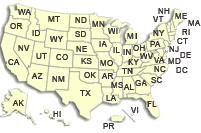Effects of Hurricane Floyd inland flooding, September-October 1999, on tributaries to Pamlico Sound, North Carolina
Journal Article
By Jerad D. Bales
Abstract
Hurricane Floyd in September 1999 caused disastrous flooding from South Carolina to Massachusetts in the United States, with particularly severe and prolonged flooding in eastern North Carolina resulting in record floodflow loadings of freshwater and contaminants to Pamlico Sound, North Carolina. The inland flooding, water quality, and loadings to Pamlico Sound were determined as part of a multi-agency response to the floods and in an effort to understand the effects of the floods on the greater Pamlico Sound Basin. All major river basins draining to Pamlico Sound experienced floods at the 500-yr recurrence level. The volume of flood waters entering Pamlico Sound during September-October 1999 was estimated to be equivalent to about 95% of the volume of Pamlico Sound, meaning that flood waters could have essentially displaced most of the water present in Pamlico Sound. Nitrogen and phosphorus loads to the Pamlico River estuary and Neuse River estuary, the two principal estuaries draining to Pamlico Sound, in a 36-d period during the flooding were between 50-90% of the long term average annual loads. Pesticide concentrations in flood waters were surprisingly high, given the amount of dilution produced by the floodwaters.
Citation:
Bales, J.D., 2003, Effects of Hurricane Floyd inland flooding, September-October 1999, on tributaries to Pamlico Sound, North Carolina: Estuaries, v. 26, no. 5, p. 1319-1328.
|
For more information, contact |
To order printed copies, contact |
North Carolina Water Science Center
U.S. Geological Survey
3916 Sunset Ridge Road
Raleigh, North Carolina 27607
(919) 571-4000
E-mail
|
Estuaries |
|
